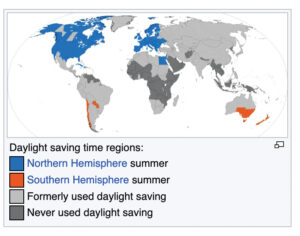Carol Fisher-Linn
Daylight Saving Time (not Daylight SavingS Time!) Yep, It’s here again!
Spring Forward – Fall Back. We are now into the ‘fall back’ time of year. That means that at 2am on Sunday, November 5th, Daylight Saving Time (DST) ends, and we turn our clocks BACK one hour. Apparently, we do this to have better use of natural daylight.
I grew up without having to deal with DST. The U.S. Uniform Time Act wasn’t enacted until 1966. It outlined that clocks should be set forward on the last Sunday in April and set back the last Sunday in October. In 2006, the date was amended to the first Sunday of November, allegedly to give Trick or Treaters more daylight on Halloween. I found this “fact” in only one place, but the idea so appealed to me, I’m sharing. You decide how true it is. This year we turn our clocks back on Sunday morning at 2am, or when we retire on Saturday night. If we go to bed at 11pm, we are really going to bed at 10pm. We recover that extra hour of sleep we lost in spring when we jumped forward an hour. However, that’s about the only good of it, some will say.

Have you noticed how it is getting darker earlier? If it’s dark today at 5pm, it will be dark at 4 pm after November 5th. Don’t you hate that? Not only that, Dr. Rajkumar Dasgupta, associate professor of clinical medicine at the University of Southern California Keck School of Medicine in Los Angeles, in an interview with CNN, claims that the ending of DST and the falling back can initiate cluster headaches. Says he, “despite being a seemingly small shift, DST can significantly impact our circadian rhythm, which regulates our sleep-wake cycle.” He goes on to warn about depression when things get darker.
Goodness! Here’s a simple solution … sit under a lamp or get out into bright places and be with your friends. Your summer gardening/outdoor chores are done for six months so now is the time to get out and be social. Not only that, but it’s also Theater season, which is another bonus of this time of year. And in another two months, we will be in the swing of ski season in Ellicottville and the region. There is nothing dark about the lighted hills as you merrily shush down the slopes!
How did all this foolishness begin, anyway? Well, some say it was Ben Franklin who lobbied for the changes. Not so, he simply wrote a satire-filled essay about having been unpleasantly wakened at 6am by the summer sun in France, while he was an envoy there. He opined that Parisians, simply by waking up at dawn, could save huge sums of money through “the economy of using sunshine instead of candles.” An Englishman by the name of William Willett was likely the first to campaign to implement daylight saving time so people could enjoy more sunshine. He lobbied for it for years until his death, to no avail.
Along came World War I and Germany chose to embrace daylight saving time to conserve electricity. The UK followed within a few weeks, introducing “summertime.” They each stopped the custom, then revived it again in WWII.
The United States did also implement it as a war measure, but not for the cause of farmers as is often stated. The farmers and their cows hated it as it was very disruptive. It was repealed in 1919, then brought back in WWII, to be again ended three weeks after war’s end. Then the fun began with states and localities left on their own to do what they wished with DST. By 1963, Time magazine called the kerfuffle a “chaos of clocks.” Order came in 1966 with the enactment of the Uniform Time Act … but, states still had the option of remaining on standard time year-round. Along with Hawaii and Arizona, some Amish communities also opted not to participate. The fact is, around the world, only about one-quarter of the world’s population observe daylight saving time. So, we live with it and enjoy the light each of us brings into other’s lives.
